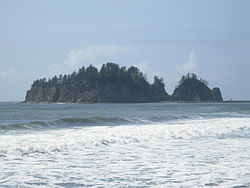La Push, Washington
| La Push, Washington | |
|---|---|
| Unincorporated community | |

James Island from the beach at La Push
|
|
| Location within the state of Washington | |
| Coordinates: 47°54′19″N 124°37′34″W / 47.90528°N 124.62611°WCoordinates: 47°54′19″N 124°37′34″W / 47.90528°N 124.62611°W | |
| Country | United States |
| State | Washington |
| County | Clallam |
| Population (2000) | |
| • Total | 371 |
| Time zone | Pacific (PST) (UTC-8) |
| • Summer (DST) | PDT (UTC-7) |
| ZIP codes | 98350 |
La Push is a small unincorporated community situated at the mouth of the Quileute River in Clallam County, Washington, United States. La Push is the largest community within the Quileute Indian Reservation, which is home to the federally recognized Quileute tribe. La Push is known for its whale-watching and natural beauty.
The name La Push is from French La Bouche, meaning "The Mouth" of the Quillayute River, adapted into Chinook Jargon. Two well-known beaches are nearby: Rialto Beach to the north of the river mouth and La Push Beach to the south.
La Push has the westernmost ZIP Code in the contiguous United States, 98350.
La Push has a very wet oceanic climate. The climate is moderated and strongly influenced by the Pacific Ocean, which renders very mild winters for a northerly latitude. Located to the west of the Olympic Mountains, La Push and the surrounding coastline absorb considerable rainfall dropped along the mountain front. The warmest month is August and the coolest month is December.
La Push, 14 miles from Forks, is home to the Quileute Tribe. Tribal members traditionally built cedar canoes for a variety of uses; they ranged in size from two-man to ocean-going freight vessels capable of carrying three tons. The Quileute ranked second only to the Makah as whalers, and first among all the tribes as seal hunters. They bred special woolly-haired dogs, and spun and wove their hair into prized warm blankets. According to the stories, the Quileutes only kin, the Chimakum, were separated from them by a great flood that swept them to the Quimper Peninsula on the other side of the North Olympic Peninsula. There they were attacked and destroyed in the 1860s by Chief Seattle and the Suquamish Tribe.
...
Wikipedia

